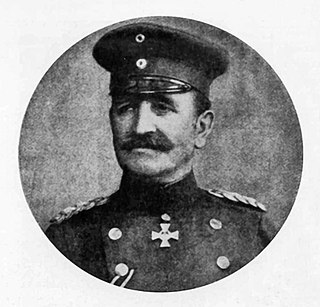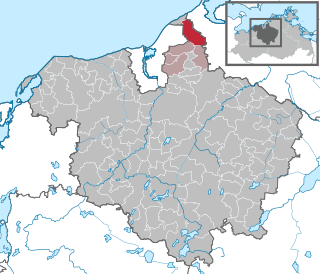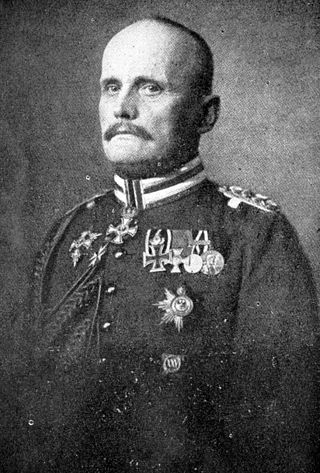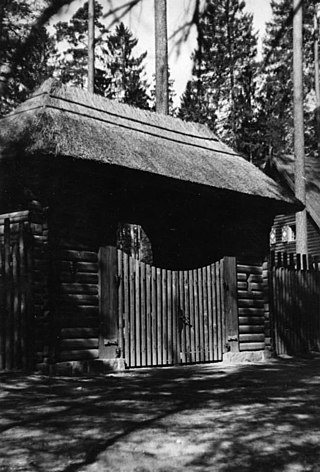
The Rominten Hunting Lodge (German: Jagdschloss Rominten) was the residence of Kaiser Wilhelm II in the Rominter Heath in East Prussia.

The Rominten Hunting Lodge (German: Jagdschloss Rominten) was the residence of Kaiser Wilhelm II in the Rominter Heath in East Prussia.
The electoral Hunting Lodge of Rominten ("Kurfürstliche Jagdbude Rominten") was first mentioned in historical records in 1572. In 1674, a new lodge was built, as the old one had fallen into disrepair. By the late 19th century, neither lodge was in existence; all that remained was a small forestry workers' settlement, a tavern and a forester's office. [1]
Prince Friedrich Karl of Prussia rediscovered the Rominter Heath as a potential hunting ground. Kaiser Wilhelm II first visited the Heath in 1890 and decided to build a Royal Hunting Lodge at Theerbude [2] (lit: Tarhut). The building was constructed by Norwegian workers to a Norwegian Dragestil design, following plans drawn up by Holm Hansen Munthe and Ole Sverre. The materials were also imported from Norway. The Kaiser first stayed at the new lodge in autumn 1891. [1] [3]
A small Norwegian Stave Church-style chapel dedicated to Saint Hubertus (the patron saint of hunting) [4] was built in 1893, and Theerbude was renamed "Kaiserlich Rominten" (Imperial Rominten) on 13 September 1897. Over the following years, a youth hostel and an orphanage were built, and the village became a popular tourist resort. An "Empress-wing" was added to the lodge in 1904. [1]
Wilheim II spent several weeks each fall at Rominten and at his other retreats in Prökelwitz and Hubertusstock. Rominten had the distinction of being the place where he and his ministers made the most important decisions regarding improvements to the navy and ship-building. [5] Government ministers would travel out to the lodge from Berlin. Most of Wilhelm's time at Rominten, however, was spent hunting. [5] He and his entourage would rise at 5:00 each morning and be driven out to the forest. Standing on special platforms, they would wait for herders to drive deer and elk toward their positions. [6]
From 22 September to 2 October 1913, Wilhelm II visited the lodge for the last time. In his 23 years of hunting on the Rominter Heath, he had brought down 327 deer. [7]
After World War I, the Lodge remained the private property of Wilhelm II, although the exiled Kaiser would never return to Rominten. In September 1933, Wilhelm refused to allow Hermann Göring to stay in the lodge; Göring subsequently built his own Reichsjägerhof Rominten just a few miles away, with a game reserve extending nearly 100 square miles (260 km2). [4] [8] After Wilhelm's death in 1941, Göring forced the heirs to sell the Rominten Hunting Lodge to the State of Prussia (of which Göring was Minister-President) for his own use. [9]
After World War II, the region became part of the Soviet Union. The village was demolished and the lodge was re-erected in Kaliningrad's Central Park, to serve as the seat of the park administration. A bronze statue of a deer was moved to the Glinka Park in Smolensk; another deer statue was moved to Sosnovka near Moscow. [10]
Today, the village no longer exists, as the area is located directly on the Polish–Russian border. [11]

Wilhelm II was the last German Emperor and King of Prussia from 1888 until his abdication in 1918, which marked the end of the German Empire and the House of Hohenzollern's 300-year reign in Prussia and 500-year reign in Brandenburg.
Krasnolesye is a settlement in Nesterovsky District of Kaliningrad Oblast, Russia, situated on the Krasnaya River (Rominta) close to the border with Poland, in the north of the Romincka Forest. East of Krasnolesye lies Lake Vistytis.

Lieutenant General Kuno Augustus Friedrich Karl Detlev Graf von Moltke, adjutant to Kaiser Wilhelm II and military commander of Berlin, was a principal in the homosexual scandal known as the Harden-Eulenburg Affair (1907) that rocked the Kaiser's entourage. Moltke was forced to leave the military service.

The German Emperor was the official title of the head of state and hereditary ruler of the German Empire. A specifically chosen term, it was introduced with the 1 January 1871 constitution and lasted until the official abdication of Wilhelm II on 9 November 1918. The Holy Roman Emperor is sometimes also called "German Emperor" when the historical context is clear, as derived from the Holy Roman Empire's official name of "Holy Roman Empire of the German Nation" from 1512.

Duchess Cecilie Auguste Marie of Mecklenburg-Schwerin was the last German Crown Princess and Crown Princess of Prussia as the wife of Wilhelm, German Crown Prince, the son of Wilhelm II, German Emperor.
Dragestil is a style of design and architecture that originated in Norway and was widely used principally between 1880 and 1910. It is a variant of the more embracing National Romantic style and an expression of Romantic nationalism.

Romincka Forest, also known as Krasny Les or Rominte Heath, is an extended forest and heath landscape stretching from the southeast of Russian Kaliningrad Oblast to the northeast of Polish Warmian-Masurian Voivodeship.

Gelbensande is a municipality in the German state of Mecklenburg-Vorpommern. It is located in the Rostock district, near Rostock, Ribnitz-Damgarten and Stralsund. Four other villages are part of Gelbensande.
Carinhall was the country residence of Hermann Göring, built in the 1930s on a large hunting estate north-east of Berlin in the Schorfheide Forest, in the north of Brandenburg, between the lakes of Großdöllner See and Wuckersee.

Holm Hansen Munthe was a Norwegian architect. He was a leading representative of dragon style architecture (Dragestil) which originated in Norway and was widely used principally between 1880 and 1910.
Szeroki Bór Piski is a settlement in the administrative district of Gmina Pisz, within Pisz County, Warmian-Masurian Voivodeship, in northern Poland. It lies approximately 8 kilometres (5 mi) west of Pisz and 81 km (50 mi) east of the regional capital Olsztyn.

Moriz Freiherr von Lyncker was a Prussian officer of the German Empire and Chief of the Military Cabinet of Emperor Wilhelm II.

Georg Alexander von Müller was an Admiral of the Imperial German Navy and a close friend of the Kaiser in the run up to the First World War.

The Latin phrase bellum se ipsum alet or bellum se ipsum alit, and its German rendering Der Krieg ernährt den Krieg describe the military strategy of feeding and funding armies primarily with the resources of occupied territories. It is closely associated with mass starvation in the population of these territories. The phrase, coined by Ancient Roman statesman Cato the Elder, is primarily associated with the Thirty Years' War (1618–1648).

Kaliningrad Central Park is a park in Kaliningrad, Russia. It was known as Luisenwahl while part of Königsberg, Germany, until 1945.

The Reichsjägerhof Rominten was Hermann Göring's Hunting Lodge in the Rominter Heath in East Prussia. After the German attack on the Soviet Union, it temporarily served as Göring's headquarters.

Emil Friedrich Franz Maximilian Graf von Schlitz genannt von Görtz was a German sculptor, Hessian nobleman, cultural policymaker and confidant of Kaiser Wilhelm II.

The abdication of Wilhelm II as German Emperor and King of Prussia was declared by Chancellor Maximilian of Baden on 9 November 1918; it was formally affirmed by a written statement of Wilhelm on 28 November, made while in exile in Amerongen, the Netherlands. The abdication caused the German Empire to dissolve and concluded the House of Hohenzollern's 500-year rule over Prussia and its predecessor state, Brandenburg. Wilhelm reigned from 15 June 1888 to 9 November 1918. As a result of the abdication and the German Revolution of 1918–19, the nobility as a legally-defined class was abolished. Following the proclamation of the Weimar Constitution on 11 August 1919, all Germans were declared equal before the law. The rulers of the twenty-two constituent states of the Empire also had to relinquish their monarchical titles and domains.

The Jagdschloss Grunewald, a hunting lodge, is the oldest preserved castle of Berlin, Germany. It is on the south waterfront of the Grunewaldsee and is part of the locality Dahlem in the borough Steglitz-Zehlendorf.
Hermann Epenstein, known from 1910 until the abolition of nobility in Austria in 1919 as Hermann Epenstein Ritter von Mauternburg; was a German-Austrian physician and merchant.